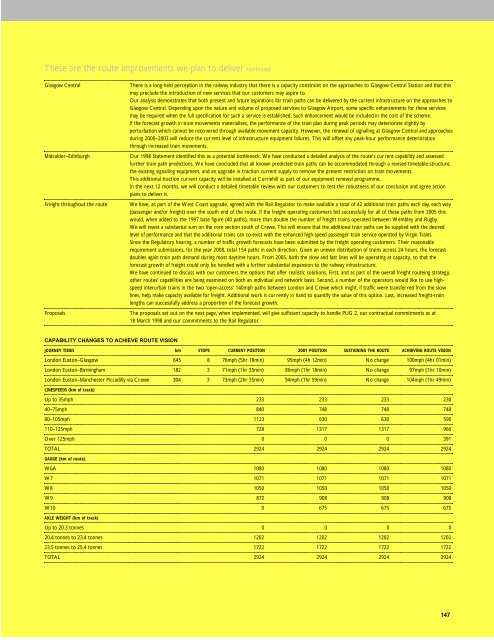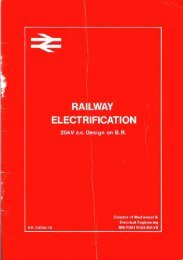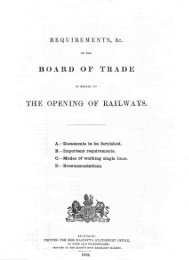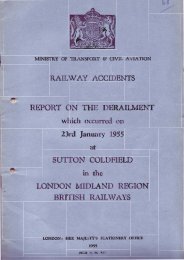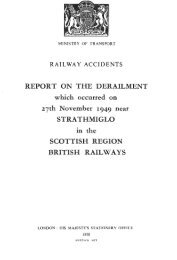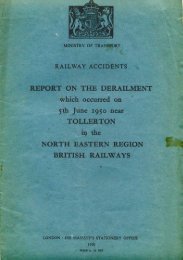R A I LT R AC K - The Railways Archive
R A I LT R AC K - The Railways Archive
R A I LT R AC K - The Railways Archive
Create successful ePaper yourself
Turn your PDF publications into a flip-book with our unique Google optimized e-Paper software.
<strong>The</strong>se are the route improvements we plan to deliver continued<br />
Glasgow Central <strong>The</strong>re is a long-held perception in the railway industry that there is a capacity constraint on the approaches to Glasgow Central Station and that this<br />
may preclude the introduction of new services that our customers may aspire to.<br />
Our analysis demonstrates that both present and future aspirations for train paths can be delive red by the current infrastructure on the ap p roaches to<br />
G l a s gow Central. Depending upon the nature and volume of proposed services to Glasgow Airport, some specific enhancements for these serv i c e s<br />
m ay be re q u i red when the full specification for such a service is established. Such enhancement would be included in the cost of the scheme.<br />
If the forecast growth in train movements materialises, the performance of the train plan during peak periods may deteriorate slightly by<br />
perturbation which cannot be recovered through available movement capacity. However, the renewal of signalling at Glasgow Central and approaches<br />
during 2000–2003 will reduce the current level of infrastructure equipment failures. This will offset any peak-hour performance deterioration<br />
through increased train movements.<br />
Midcalder–Edinburgh Our 1998 Statement identified this as a potential bottleneck. We have conducted a detailed analysis of the route’s current capability and assessed<br />
further train path predictions. We have concluded that all known predicted train paths can be accommodated through a revised timetable structure,<br />
the existing signalling equipment, and an upgrade in traction current supply to remove the present restriction on train movements.<br />
This additional traction current capacity will be installed at Curriehill as part of our equipment renewal programme.<br />
In the next 12 months, we will conduct a detailed timetable review with our customers to test the robustness of our conclusion and agree action<br />
plans to deliver it.<br />
Freight throughout the route We have, as part of the West Coast upgrade, agreed with the Rail Regulator to make available a total of 42 additional train paths each day, each way<br />
(passenger and/or freight) over the south end of the route. If the freight operating customers bid successfully for all of these paths from 2005 this<br />
would, when added to the 1997 base figure (40 paths), more than double the number of freight trains operated between Wembley and Rugby.<br />
We will invest a substantial sum on the core section south of Crewe. This will ensure that the additional train paths can be supplied with the desire d<br />
l evel of performance and that the additional trains can co-exist with the enhanced high-speed passenger train service operated by Virgin Tr a i n s .<br />
Since the Regulatory hearing, a number of traffic growth forecasts have been submitted by the freight operating customers. <strong>The</strong>ir reasonable<br />
requirement submissions, for the year 2008, total 154 paths in each direction. Given an uneven distribution of trains across 24 hours, the forecast<br />
doubles again train path demand during most daytime hours. From 2005, both the slow and fast lines will be operating at capacity, so that the<br />
forecast growth of freight could only be handled with a further substantial expansion to the railway infrastructure.<br />
We have continued to discuss with our customers the options that offer realistic solutions. First, and as part of the overall freight routeing strategy,<br />
other routes’ capabilities are being examined on both an individual and network basis. Second, a number of the operators would like to use highspeed<br />
interurban trains in the two ‘open-access’ 140mph paths between London and Crewe which might, if traffic were transferred from the slow<br />
lines, help make capacity available for freight. Additional work is currently in hand to quantify the value of this option. Last, increased freight-train<br />
lengths can successfully address a proportion of the forecast growth.<br />
Proposals <strong>The</strong> proposals set out on the next page, when implemented, will give sufficient capacity to handle PUG 2, our contractual commitments as at<br />
18 March 1998 and our commitments to the Rail Regulator.<br />
CAPABILITY CHANGES TO <strong>AC</strong>HIEVE ROUTE VISION<br />
JOURNEY TIMES km STOPS CURRENT POSITION 2001 POSITION SUSTAINING THE ROUTE <strong>AC</strong>HIEVING ROUTE VISION<br />
London Euston–Glasgow 645 8 76mph (5hr 18min) 95mph (4h 12min) No change 100mph (4hr 01min)<br />
London Euston–Birmingham 182 3 71mph (1hr 35min) 86mph (1hr 18min) No change 97mph (1hr 10min)<br />
London Euston–Manchester Piccadilly via Crewe 304 3 73mph (2hr 35min) 94mph (1hr 59min) No change 104mph (1hr 49min)<br />
LINESPEEDS (km of track)<br />
Up to 35mph 233 233 233 230<br />
40–75mph 840 748 748 748<br />
80–105mph 1123 630 630 590<br />
110–125mph 728 1317 1317 966<br />
Over 125mph 0 0 0 391<br />
TOTAL 2924 2924 2924 2924<br />
GAUGE (km of route)<br />
W6A 1080 1080 1080 1080<br />
W7 1071 1071 1071 1071<br />
W8 1050 1050 1050 1050<br />
W9 872 908 908 908<br />
W10 0 675 675 675<br />
AXLE WEIGHT (km of track)<br />
Up to 20.3 tonnes 0 0 0 0<br />
20.4 tonnes to 23.4 tonnes 1202 1202 1202 1202<br />
23.5 tonnes to 25.4 tonnes 1722 1722 1722 1722<br />
TOTAL 2924 2924 2924 2924<br />
147


